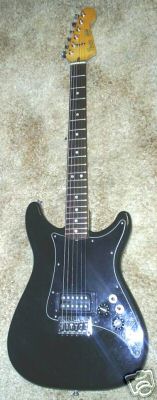History
The original concept for the Lead guitar series, including the name "Lead" came from Dennis Handa, then Marketing director for Fender Guitars. The idea was to have a guitar that was cheaper than the Stratocaster and be attractive to players because of the neck feel as well as the pickup options. The smaller headstock and the neck were both patterned after earlier Fender necks. Originally Steve Morse of the Dixie Dregs was the first endorser of the guitar and premiered it at the NAMM International Music & Sound Expo in Atlanta, Georgia. The Lead Guitars were manufactured between 1979 and 1982 by the Fender Musical Equipment Co. under the direction of Gregg Wilson and Freddie Tavares. Gregg Wilson was succeeded by John Page, who eventually headed the Fender Custom Shop. The Lead Series have elements of the Stratocaster and Telecaster in their design with a body that is slightly smaller and with a slightly different shape than the Stratocaster, a Stratocaster-like neck (and headstock), and hardtail bridge with Telecaster-like string ferrules on the back of the body. [1]
The Lead Series headstock was smaller than that of the then Stratocaster models and similar though not identical to the 1954 Stratocaster design. The Stratocaster models at the time of the Lead Series release in late 1979 were still using the larger headstock design until the introduction of the Dan Smith Stratocaster in 1981. At some point during 1982 the lower bout of the headstock was shifted towards the body giving the headstock a more elongated look.
The Lead Series were manufactured at Fender's Fullerton, California plant and priced below the Stratocaster models of the time (approx. $495.00). They were eventually replaced in Fender's line up by the Squier JV model in 1982 as Fender expanded its operations by starting Fender Japan.
In January 2020 Fender reintroduced the Lead II and III as a part of their Player series. These Made in Mexico recreations sport an alder body, two slanted alnico V single coils (Lead II), alnico II humbuckers (Lead III) and a modern C-shaped maple neck with maple or pau ferro fretboard, 9.5” radius, 22 medium jumbo frets. Other features include a synthetic bone nut, "F" tuners and a string-through-body bridge with block saddles. [2]
This page is based on this
Wikipedia article Text is available under the
CC BY-SA 4.0 license; additional terms may apply.
Images, videos and audio are available under their respective licenses.
